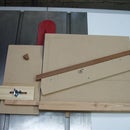Introduction: Asphalt Shingle Replacement, Stop Those Roof Leaks!
If you have a leaky roof, and your roof has standard asphalt shingles, you can repair it yourself. There are MANY instructions on the Internet, and an excellent Instructable How to replace a damaged shingle by sbrown. You should view these valuable instructions, they provide information that I will not cover here.
This Instructables provides a few tips learned on a recent roof repair. They worked for me, may or may not work for you. But I'm pretty sure there will be some things here you will not see elsewhere.
I started with the venerable blue tarp on my garage roof. Where I live in Washington State, it started raining last week. May stop next July.
This Instructables provides a few tips learned on a recent roof repair. They worked for me, may or may not work for you. But I'm pretty sure there will be some things here you will not see elsewhere.
I started with the venerable blue tarp on my garage roof. Where I live in Washington State, it started raining last week. May stop next July.
Step 1: Pinpoint the Leak Source
I found the apparent location of the leak on the underside of the roof. No, this is not always where the water is entering above, the water can travel. But it should be close.
Next, I taped a stack of rare-earth (neodymium) magnets on the underside of the roof at the high point of the leak.
Then I went back on top the roof with a cheap compass. Knowing approximately the area of the leak, the compass quickly zoomed in on the magnets under the roof. To confirm, I placed another magnet on the roof to mark the spot.
Next, I taped a stack of rare-earth (neodymium) magnets on the underside of the roof at the high point of the leak.
Then I went back on top the roof with a cheap compass. Knowing approximately the area of the leak, the compass quickly zoomed in on the magnets under the roof. To confirm, I placed another magnet on the roof to mark the spot.
Step 2: How to Get Those Roofing Nails Out!
Now that the leak point has been found (hopefully), a couple of shingles will have to be removed.
To remove them, reach under them with a pry bar until you encounter the nails.
Not too hard with a newer roof. But with an old roof and bad shingles, another story. I ended up tearing away portions of the old flimsy shingles to get to the nails. Why not, they are going into the trash anyway.
Two problems with removing the nails, not mentioned elsewhere:
Often they are driven really deep into the shingle, since the roofers use pneumatic driven nailers. Not easy to get your nail puller under. So I went into the attic, under the roof work area, and found the roofing nails protruding about 1/4". On my target shingles, I drove the nails out, so they were easy to find and remove back on the roof. Be sure to remove all the nails that drive out!
It is really easy to tear the tarpaper underlayment when messing around with the sharp pry bar. All the more reason to tear away the old bad shingles first, so you see what you are doing.
To remove them, reach under them with a pry bar until you encounter the nails.
Not too hard with a newer roof. But with an old roof and bad shingles, another story. I ended up tearing away portions of the old flimsy shingles to get to the nails. Why not, they are going into the trash anyway.
Two problems with removing the nails, not mentioned elsewhere:
Often they are driven really deep into the shingle, since the roofers use pneumatic driven nailers. Not easy to get your nail puller under. So I went into the attic, under the roof work area, and found the roofing nails protruding about 1/4". On my target shingles, I drove the nails out, so they were easy to find and remove back on the roof. Be sure to remove all the nails that drive out!
It is really easy to tear the tarpaper underlayment when messing around with the sharp pry bar. All the more reason to tear away the old bad shingles first, so you see what you are doing.
Step 3: Tools and Supplies.
Forgot to put this in earlier:
Tools:
Two pry bar/nail pullers, one large, one small. I sharpened the tip of the small one in order to get under the roofing nails.
Hammer.
Gloves.
Flashlight - I needed this to see under shingles to locate nails.
Trowel for spreading roofing cement.
Supplies.
New shingles. I took an old one to the store so I could find a close match.
Tarpaper underlayment. Get the 30# type, not the thin 15#. I'll explain later.
Roofing cement (tar/sealant). I got a gallon of Henry brand. messy, very messy. You will pitch the gloves later.
Step 4: Find and Remove Roofing Nails for Bad Shingles.
That's where the long pry bar come in.
To remove this shingle (under pry bar), you will have to remove nails located under the next two higher shingles. It wasn't long before I just ripped off much of the shingle I was removing.
The second photo here shows the head of a roofing nail protruding about 1/4" after I had hammered it out from below. Otherwise I would have had to dig into the shingle to get under the nail head.
To remove this shingle (under pry bar), you will have to remove nails located under the next two higher shingles. It wasn't long before I just ripped off much of the shingle I was removing.
The second photo here shows the head of a roofing nail protruding about 1/4" after I had hammered it out from below. Otherwise I would have had to dig into the shingle to get under the nail head.
Step 5: Don't Rip the Underlayment!
You want to leave the underlayment (tarpaper) intact. I tore the tarpaper here with my prybar, looking for a nail. It is very easy to tear 15# underlayment, which many commercial roofers use. Be sure any tears are repaired with the roofing cement.
Step 6: Install New Tarpaper
This photo shows me sliding new 30# tarpaper under the existing tarpaper. You want to install new tarpaper as far up the roof as possible, under the area where the new shingles will be placed. The 30# stuff is stiff enough to do this, 15# may not work.
Step 7: Job Done, Wait for a Rain Storm for Results.
I only replaced three shingles for this job, plus used roofing cement under a few more that were cracked.




